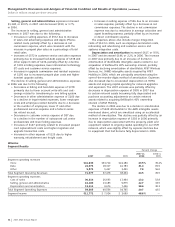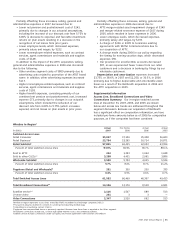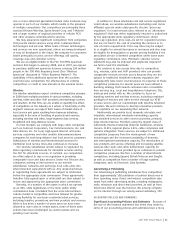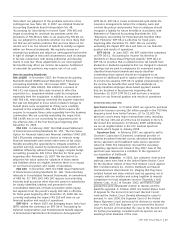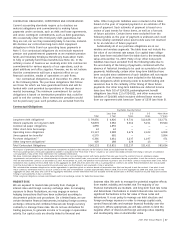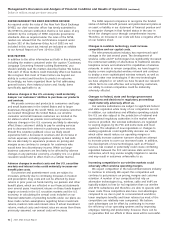AT&T Wireless 2007 Annual Report Download - page 43
Download and view the complete annual report
Please find page 43 of the 2007 AT&T Wireless annual report below. You can navigate through the pages in the report by either clicking on the pages listed below, or by using the keyword search tool below to find specific information within the annual report.
2007 AT&T Annual Report
| 41
one or more enhanced specialized mobile radio licensees may
operate in each of our markets, which results in the presence
of multiple competitors. Our competitors are principally three
national (Verizon Wireless, Sprint Nextel Corp. and T-Mobile)
and a larger number of regional providers of cellular, PCS
and other wireless communications services.
We may experience significant competition from companies
that provide similar services using other communications
technologies and services. While some of these technologies
and services are now operational, others are being developed
or may be developed in the future. We compete for customers
based principally on price, service offerings, call quality,
coverage area and customer service.
We are an eligible bidder in the FCC 700 MHz spectrum
auctions that began in January 2008, and in 2007, we agreed
to purchase additional spectrum licenses covering 196 million
people in the 700 MHz frequency band. (See “Wireless
Spectrum” discussed in “Other Business Matters”). The
availability of this additional spectrum from the auctions
could increase competition, the effectiveness of existing
competition, or result in new entrants in the wireless arena.
Wireline
Our wireline subsidiaries expect continued competitive pressure
in 2008 from multiple providers in various markets, including
wireless, cable and other VoIP providers, interexchange carriers
and resellers. At this time, we are unable to quantify the effect
of competition on the industry as a whole, or financially on this
segment. However, we expect both losses of market share in
local service and gains resulting from business initiatives,
especially in the area of bundling of products and services,
including wireless and video, large-business data services,
broadband and long-distance service.
In most markets, we compete with large cable companies,
such as Comcast Corporation, Cox Communications, Inc. and
Time Warner Inc., for local, high-speed Internet and video
services customers and other smaller telecommunications
companies for both long-distance and local services customers.
Substitution of wireless and Internet-based services for
traditional local service lines also continues to increase.
Our wireline subsidiaries remain subject to regulation by
state regulatory commissions for intrastate services and by
the FCC for interstate services. In contrast, our competitors
are often subject to less or no regulation in providing
comparable voice and data services. Under the Telecom Act,
companies seeking to interconnect to our wireline
subsidiaries’ networks and exchange local calls enter into
interconnection agreements with us. Any unresolved issues
in negotiating those agreements are subject to arbitration
before the appropriate state commission. These agreements
(whether fully agreed-upon or arbitrated) are then subject to
review and approval by the appropriate state commission.
Recently, in a number of the states in which we operate
as an ILEC, state legislatures or the state public utility
commissions have concluded that the voice telecommuni-
cations market is competitive and have allowed for greater
pricing flexibility for non-basic residential retail services,
including bundles, promotions and new products and services.
While it has been a number of years since we have been
allowed to raise rates in certain states, some of these state
actions have been challenged by certain parties and are
pending court review.
In addition to these wholesale rate and service regulations
noted above, our wireline subsidiaries (excluding rural carrier
affiliates) operate under state-specific elective “price-cap
regulation” for retail services (also referred to as “alternative
regulation”) that was either legislatively enacted or authorized
by the appropriate state regulatory commission. Under
price-cap regulation, price caps are set for regulated services
and are not tied to the cost of providing the services or to
rate-of-return requirements. Price-cap rates may be subject
to or eligible for annual decreases or increases and also may
be eligible for deregulation or greater pricing flexibility if the
associated service is deemed competitive under some state
regulatory commission rules. Minimum customer service
standards may also be imposed and payments required if
we fail to meet the standards.
We continue to lose access lines due to competitors
(e.g., wireless, cable and VoIP providers) who can provide
comparable services at lower prices because they are not
subject to traditional telephone industry regulation and
subsequently have lower cost structures. In response to these
competitive pressures, for several years we have utilized a
bundling strategy that rewards customers who consolidate
their services (e.g., local and long-distance telephone, DSL,
wireless and video) with us. We continue to focus on
bundling wireline and wireless services, including combined
packages of minutes and video service through our AT&T
U-verse service and our relationships with satellite television
providers. We will continue to develop innovative products
that capitalize on our expanding fiber network.
Additionally, we provide local, domestic intrastate and
interstate, international wholesale networking capacity
and switched services to other service providers, primarily
large Internet Service Providers using the largest class of
nationwide Internet networks (Internet backbone), wireless
carriers, CLECs, regional phone ILECs, cable companies and
systems integrators. These services are subject to additional
competitive pressures from the development of new
technologies and the increased availability of domestic
and international transmission capacity. The introduction of
new products and service offerings and increasing satellite,
wireless, fiber-optic and cable transmission capacity for
services similar to those provided by us continues to provide
competitive pressures. We face a number of international
competitors, including Equant, British Telecom and SingTel;
as well as competition from a number of large systems
integrators, such as Electronic Data Systems.
Advertising & Publishing
Our advertising & publishing subsidiaries face competition
from approximately 100 publishers of printed directories in
their operating areas. Direct and indirect competition also
exists from other advertising media, including newspapers,
radio, television and direct-mail providers, as well as from
directories offered over the Internet. We actively compete
on the Internet through our wholly-owned subsidiary, YPC.
ACCOUNTING POLICIES AND STANDARDS
Significant Accounting Policies and Estimates Because of
the size of the financial statement line items they relate to,
some of our accounting policies and estimates have a more



